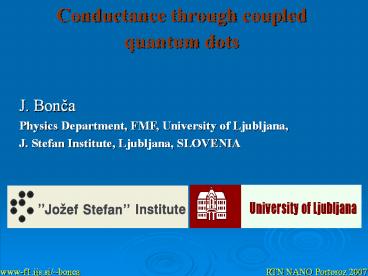Conductance through coupled quantum dots - PowerPoint PPT Presentation
1 / 20
Title:
Conductance through coupled quantum dots
Description:
... D, in the crossover regime an unstable non-Fermi liquid (NFL) fixed point exists ... ZOOM. Zitko & Bonca. PRL. 98, 047203. www-f1.ijs.si/~bonca. RTN NANO ... – PowerPoint PPT presentation
Number of Views:37
Avg rating:3.0/5.0
Title: Conductance through coupled quantum dots
1
Conductance through coupled quantum dots
J. Bonca Physics Department, FMF, University of
Ljubljana, J. Stefan Institute, Ljubljana,
SLOVENIA
2
- Collaborators
- R. Žitko, J. Stefan Inst., Ljubljana, Slovenia
- A.Ramšak and T. Rejec, FMF, Physics dept.,
University of Ljubljana and J. Stefan Inst.,
Ljubljana, Slovenia
3
Introduction
- Experimental motivation
- Three QDs
- Good agreement between CPMC and GS and NRG
approaches - Many different regimes
- tgtG three peaks in G(d) due to 3 molecular
levels - tltG a single peak in G(d) of width U
- At tltltD, in the crossover regime an unstable
non-Fermi liquid (NFL) fixed point exists - Two-stage Kodo effect is also followed by the NFL
- N-parallel QDs
- d0 SN/2 Kondo effect
- dU/2 Quantum phase transitions
4
Nature, 391 (1998)
Science, 281 (1998)
5
Double- and multiple- dot structures
Holleitner et el., Science 297, 70 (2002)
Craig et el., Science 304 , 565 (2004)
6
Quantum Dot (Anderson single impurity problem)
d
7
Three alternative methods
- Numerical Renormalization Group using Reduced
Density Matrix (NRG), Krishna-murthy, Wilkins and
Wilson, PRB 21, 1003 (1980) Costi, Hewson and
Zlatic, J. Phys. Condens. Matter 6, 2519,
(1994) Hofstetter, PRL 85, 1508 (2000). - Projection variational metod (GS), Schonhammer,
Z. Phys. B 21, 389 (1975) PRB 13, 4336 (1976),
Gunnarson and Shonhammer, PRB 31, 4185 (1985),
Rejec and Ramšak, PRB 68, 035342 (2003). - Constrained Path Monte Carlo method (CPMC),
Zhang, Carlson and Gubernatis, PRL 74 ,3652
(1995)PRB 59, 12788 (1999).
8
How to obtain G from GS properties
- CPMC and GS are zero-temperature methods ? Ground
state energy - Conditions System is a Fermi liquid
N-(noninteracting) sites, N ?8
G02e2/h
Rejec, Ramšak, PRB 68, 035342 (2003)
9
Conductance formalisms
U 0
non-equilibrium transport T ? 0, V ? 0
Landauer Büttiker formula
In Fermi liquid systems
Fisher Lee relation
10
Comparison CPMC,GS,NRG
- CPMC,
- GS-variational,
- Hartree-Fock
Rejec, Ramšak, PRB 68, 035342 (2003)
Ultt Wide-band
- NRG
Meir-Wingreen, PRL 68, 2512 (1992)
11
Comparison CPMC,GS,NRG
- CPMC,
- GS-variational,
- Hartree-Fock
- NRG
Ugtgtt Narrow-band
Meir-Wingreen, PRL 68, 2512 (1992)
12
Fermi-liquid E(f) is a universal
function of f
Number of electrons odd
Rejec, Ramšak, PRB 68, 035342 (2003)
13
Zero-bias conductance
Rejec, Ramšak, PRB 68, 035342 (2003)
14
Connection of G with charge stiffness
Rejec, Ramšak, PRB 68, 035342 (2003)
15
GS variational method
Auxiliary Hamitonian
Variational wavefunctions
Projection operators
EH the lowest eigenvalue gives the
approximation to the GS of H
16
GS variational method cont.
Using Wicks theorem
17
Three coupled quantum dotsZitko, Bonca, Rejec,
Ramsak, PRB 73, 153307 (2006)
MO
AFM
TSK
- Using NRG technique
- Using GS variational NGS 1000,2000
- Using CPMC NCPMC 100,180
18
Three coupled quantum dots
Half-filled case!
MO
AFM
TSK
- Using NRG technique
- Using GS variational NGS 1000,2000
- Using CPMC NCPMC 100,180
19
Three coupled QDs
Half-filled case!
Oguri, Nisikawa,Hewson
20
Three coupled QDs
1
2
3
Oguri, Nisikawa,Hewson, cond-mat/0504771
Half-filled case!
21
Three QDs Non-Fermi-Liquid
CvT lnT , cslnT, S(T?0)(1/2) ln 2
TK(1)
AFM
SU(2)spin x SU(2)izospin
MO
TK(2)
MO
AFM
TSK
Zitko Bonca PRL 98, 047203 Kuzmenko et
al.,Europhy.Lett. 64 218 2003 OBSERVATION Potok
et al., Cond-mat/0610721
TK(1)
TK(2)
TD
ZOOM
NFL
22
Three QDs Non-Fermi-Liquid CvT lnT , csln T
Zitko Bonca PRL 98, 047203
TK(1)
MO
AFM
AFM
MO
ZOOM
TSK
TK(2)
TK(1)
TK(2)
TD
NFL
23
Three coupled QDs Non-Fermi-Liquid
MO
AFM
TSK
Affletck et al. PRB 45, 7918 (1992)
24
Three coupled QDs Non-Fermi-Liquid
MO
AFM
TSK
25
Quantum phase transitions in parallel QDs
26
N - quantum dots
SN/2
SN/2-1
- Three different time-scales
S(S1)/3
N/4
N/8
- Separation of time-scales
- Different temperature-regimes
27
Quantum phase transitions in parallel QDs
- d0 SN/2 Kondo effect
- dU/2 ? Discontinuities in G
- Discontinuities in G ? Quantum phase transitions
28
Quantum phase transitions in parallel QDs
29
N - quantum dotsR.Z. J.B. PRB 74, 045312
(2006)
Schrieffer-Wolf
Perturbation in Vk4-th order
30
Conclusions
- Three QDs in series
- Good agreement between NRG, GS, and CPMC.
- Different phases exist
- tgtG three peaks in G(d) due to 3 molecular
levels (MO), tltG a single peak in G(d) of
width U in the AFM regime - Two-stage Kondo (TSK) regime, when tltTK
- NFL behavior is found in the crossover regime. A
good candidate for the experimental observation.
31
Conclusions
- Three QDs in series
- Good agreement between NRG, GS, and CPMC.
- Different phases exist
- tgtG three peaks in G(d) due to 3 molecular
levels (MO), tltG a single peak in G(d) of
width U in the AFM regime - Two-stage Kondo (TSK) regime, when tltTK
- NFL behavior is found in the crossover regime. A
good candidate for the experimental observation. - N-parallel QDs
- d0 SN/2 Kondo effect
- dU/2 Quantum phase transitions































